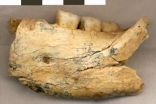(Press-News.org) Philadelphia, Pa. (February 7, 2013) – Injury to the subcortical structures of the inner brain is a major contributor to worsening neurological abnormalities after "awake craniotomy" for brain tumors, reports a study in the February issue of Neurosurgery, official journal of the Congress of Neurological Surgeons. The journal is published by Lippincott Williams & Wilkins, a part of Wolters Kluwer Health.
During a procedure intended to protect critical functional areas in the outer brain (cortex), damage to subcortical areas—which may be detectable on MRI scans—is a major risk factor for persistent neurological deficits. "Our ability to identify and preserve cortical areas of function can still result in significant neurological decline postoperatively as a result of subcortical injury," write Dr. Victoria T. Trinh and colleagues of The University of Texas MD Anderson Cancer Center, Houston.
Risk Factors for Neurological Deficits after Awake Craniotomy
The researchers analyzed factors associated with worsening neurological function after awake craniotomy for brain tumor surgery. In awake craniotomy, the patient is sedated but conscious so as to be able to communicate with the surgeon during the operation.
The patient is asked to perform visual and verbal tasks while specific areas of the cortex are stimulated, generating a functional map of the brain surface. This helps the surgeon navigate safely to the tumor without damaging the "eloquent cortex"—critical areas of the brain involved in language or movement.
The study included 241 patients who underwent awake craniotomy with functional brain mapping from 2005 through 2010. Of these, 40 patients developed new neurological abnormalities. Dr. Trinh and colleagues examined potential predictive factors—including changes on a type of MRI scan called diffusion-weighted imaging (DWI).
Of the 40 cases with new neurological deficits, 36 developed while the surgeon was operating in the subcortical areas of the brain. These are the inner structures of the brain, located beneath the outer, folded brain cortex. Just one abnormality developed while the surgeon was operating in the cortex only.
MRI Changes May Reflect Subcortical Damage
Neurological abnormalities developing while the surgeon was operating in the subcortex were likely to remain after surgery, and to persist at three months' follow-up evaluation. Dr. Trinh and coauthors write, "Patients with intraoperative deficits during subcortical dissection were over six times more likely to have persistently worsened neurological function at three-month follow-up."
In these patients, MRI scans showing more severe changes in the DWI pattern in the subcortex also predicted lasting neurological abnormalities. Of patients who had neurological deficits immediately after surgery and significant DWI changes, 69 percent had persistent deficits three months after surgery.
Patients who had "positive" cortical mapping—that is, in whom eloquent cortex was located during functional mapping—were somewhat more likely to have neurological abnormalities immediately after surgery. However, the risk of lasting abnormalities was not significantly higher compared to patients with negative cortical mapping.
Awake craniotomy with brain stimulation produces a "real-time functional map" of the brain surface that is invaluable to the neurosurgeon in deciding how best to approach the tumor. The new results suggest that, even when the eloquent cortex is not located on cortical mapping, subcortical areas near the tumor can still be injured during surgery. "Subcortical injury is the primary cause of neurological deficits following awake craniotomy procedures," Dr. Trinh and colleagues write.
The researchers add, "Preserving subcortical areas during tumor resections may reduce the severity of both immediate and late neurological sequelae." Based on their findings, they believe subcortical mapping techniques may play an important role in avoiding complications after awake craniotomy.
###
About Neurosurgery
Neurosurgery, the Official Journal of the Congress of Neurological Surgeons, is your most complete window to the contemporary field of neurosurgery. Members of the Congress and non-member subscribers receive 3,000 pages per year packed with the very latest science, technology, and medicine, not to mention full-text online access to the world's most complete, up-to-the-minute neurosurgery resource. For professionals aware of the rapid pace of developments in the field, Neurosurgery is nothing short of indispensable.
About Lippincott Williams & Wilkins
Lippincott Williams & Wilkins (LWW) is a leading international publisher of trusted content delivered in innovative ways to practitioners, professionals and students to learn new skills, stay current on their practice, and make important decisions to improve patient care and clinical outcomes. LWW is part of Wolters Kluwer Health, a leading global provider of information, business intelligence and point-of-care solutions for the healthcare industry. Wolters Kluwer Health is part of Wolters Kluwer, a market-leading global information services company with 2011 annual revenues of €3.4 billion ($4.7 billion).
Subcortical damage is 'primary cause' of neurological deficits after 'awake craniotomy'
Even with brain mapping, damage to inner brain structures can occur during conscious brain surgery, reports Neurosurgery
2013-02-07
ELSE PRESS RELEASES FROM THIS DATE:
No increase in brain aneurysm rupture risk during pregnancy and delivery
2013-02-07
Philadelphia, Pa. (February 7, 2013) – For women with aneurysms involving the brain blood vessels, pregnancy and delivery don't appear to increase the risk of aneurysm rupture, reports a paper in the February issue of Neurosurgery, official journal of the Congress of Neurological Surgeons. The journal is published by Lippincott Williams & Wilkins, a part of Wolters Kluwer Health.
The study also finds that women with known, unruptured aneurysms have a very high rate of cesarean delivery—which isn't supported by evidence and "may not be necessary," according to Dr. Brian ...
NASA sees the sun produce 2 CMEs
2013-02-07
In the evening of Feb. 5, 2013, the sun erupted with two coronal mass ejections or CMEs that may glance near-Earth space. Experimental NASA research models, based on observations from the Solar Terrestrial Relations Observatory (STEREO) and ESA/NASA's Solar and Heliospheric Observatory, show that the first CME began at 7 p.m. EST and left the sun at speeds of around 750 miles per second. The second CME began at 10:36 p.m. EST and left the sun at speeds of around 350 miles per second. Historically, CMEs of this speed and direction have been benign.
Not to be confused with ...
Animal magnetism: First evidence that magnetism helps salmon find home
2013-02-07
When migrating, sockeye salmon typically swim up to 4,000 miles into the ocean and then, years later, navigate back to the upstream reaches of the rivers in which they were born to spawn their young. Scientists, the fishing community and lay people have long wondered how salmon find their way to their home rivers over such epic distances.
How do they do that?
A new study, published in this week's issue of Current Biology and partly funded by the National Science Foundation, suggests that salmon find their home rivers by sensing the rivers' unique magnetic signature. ...
NASA scientists build first-ever wide-field X-ray imager
2013-02-07
Three NASA scientists teamed up to develop and demonstrate NASA's first wide-field-of-view soft X-ray camera for studying "charge exchange," a poorly understood phenomenon that occurs when the solar wind collides with Earth's exosphere and neutral gas in interplanetary space.
The unique collaboration involved heliophysics, astrophysics and planetary science divisions at NASA's Goddard Space Flight Center in Greenbelt, Md., and resulted in the first successful demonstration of the Sheath Transport Observer for the Redistribution of Mass (STORM) instrument and a never-before-flown ...
Same factors influence depression in stroke patients, spouse caregivers
2013-02-07
Self-esteem, optimism and perceived control influence depression in stroke survivors and their spouse caregivers — who should be treated together, according to research presented at the American Stroke Association's International Stroke Conference 2013.
Researchers, who analyzed 112 depressed stroke survivors up to 8 weeks after hospital discharge and their spouses, found self-esteem and optimism influenced each partners' depression.
"We usually have been focused on the outcome of the stroke survivor, but we found that the self-esteem and optimism of the spouse caretaker ...
Study: Number of people with Alzheimer's disease may triple by 2050
2013-02-07
MINNEAPOLIS – The number of people with Alzheimer's disease is expected to triple in the next 40 years, according to a new study published in the February 6, 2013, online issue of Neurology®, the medical journal of the American Academy of Neurology.
"This increase is due to an aging baby boom generation. It will place a huge burden on society, disabling more people who develop the disease, challenging their caregivers, and straining medical and social safety nets," said co-author Jennifer Weuve, MPH, ScD, assistant professor of medicine, Rush Institute for Healthy Aging ...
Can nerve stimulation help prevent migraine?
2013-02-07
MINNEAPOLIS – Wearing a nerve stimulator for 20 minutes a day may be a new option for migraine sufferers, according to new research published in the February 6, 2013, online issue of Neurology®, the medical journal of the American Academy of Neurology.
The stimulator is placed on the forehead, and it delivers electrical stimulation to the supraorbital nerve.
For the study, 67 people who had an average of four migraine attacks per month were followed for one month with no treatment. Then they received either the stimulation 20 minutes a day for three months or sham ...
'Listening to your heart' could improve body image, says study
2013-02-07
Women who are more aware of their bodies from within are less likely to think of their bodies principally as objects, according to research published February 6 in the open access journal PLOS ONE by Vivien Ainley and Manos Tsakiris from the Department of Psychology at Royal Holloway, University of London.
The authors asked healthy female student volunteers aged between 19 – 26 to concentrate and count their own heartbeats, simply by "listening" to their bodies. Their accuracy in this heartbeat perception test was compared with their degree of self-objectification, based ...
Despite reported dislike, older readers put in less effort when using e-readers
2013-02-07
Reading text on digital devices like tablet computers requires less effort from older adults than reading on paper, according to research published February 6 in the open access journal PLOS ONE by Matthias Schlesewsky and colleagues from Johannes Gutenberg University Mainz, Germany, in collaboration with colleagues from Georg August University Göttingen and the University of Marburg, Germany.
In the past, surveys have shown that people prefer to read paper books rather than on e-readers or tablet computers. Here, the authors evaluated the origins of this preference in ...
Features of southeast European human ancestors influenced by lack of episodic glaciations
2013-02-07
A fragment of human lower jaw recovered from a Serbian cave is the oldest human ancestor found in this part of Europe, who probably evolved under different conditions than populations that inhabited more western parts of the continent at the same time, according to research published February 6 in the open access journal PLOS ONE by William Jack Rink of McMaster University, Canada, and the international team under the direction of Dušan Mihailović, University of Belgrade, Serbia, and Mirjana Roksandic, University of Winnipeg, Canada.
The fossil was found to be ...
LAST 30 PRESS RELEASES:
University of Oklahoma researcher awarded funding to pursue AI-powered material design
Exploring how the visual system recovers following injury
Support for parents with infants at pediatric check-ups leads to better reading and math skills in elementary school
Kids’ behavioral health is a growing share of family health costs
Day & night: Cancer disrupts the brain’s natural rhythm
COVID-19 vaccination significantly reduces risk to pregnant women and baby
The role of vaccination in maternal and perinatal outcomes associated with COVID-19 in pregnancy
Mayo Clinic smartwatch system helps parents shorten and defuse children's severe tantrums early
Behavioral health spending spikes to 40% of all children’s health expenditures, nearly doubling in a decade
Digital cognitive behavioral treatment for generalized anxiety disorder
Expenditures for pediatric behavioral health care over time and estimated family financial burden
Air conditioning in nursing homes and mortality during extreme heat
The Alps to lose a record number of glaciers in the next decade
What makes a good proton conductor?
New science reporting guide published for journalists in Bulgaria
New international study reveals major survival gaps among children with cancer
New science reporting guide published for journalists in Turkey
Scientists develop a smarter mRNA therapy that knows which cells to target
Neuroanatomy-informed brain–machine hybrid intelligence for robust acoustic target detection
Eight SwRI hydrogen projects funded by ENERGYWERX
The Lundquist Institute and its start-up company Vitalex Biosciences Announces Strategic Advancement of Second-Generation fungal Vaccine VXV-01 through Phase 1 Trials under $40 Million Competitive Con
Fine particles in pollution are associated with early signs of autoimmune disease
Review article | Towards a Global Ground-Based Earth Observatory (GGBEO): Leveraging existing systems and networks
Penn and UMich create world’s smallest programmable, autonomous robots
Cleveland researchers launch first major study to address ‘hidden performance killer’ in athletes
To connect across politics, try saying what you oppose
Modulating key interaction prevents virus from entering cells
Project explores barriers to NHS career progression facing international medical graduates
Jeonbuk National University researchers explore the impact of different seasonings on the flavor perception of Doenjang soup
Two Keck Medicine of USC Hospitals named Leapfrog Top Teaching Hospitals
[Press-News.org] Subcortical damage is 'primary cause' of neurological deficits after 'awake craniotomy'Even with brain mapping, damage to inner brain structures can occur during conscious brain surgery, reports Neurosurgery



